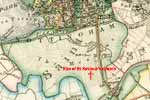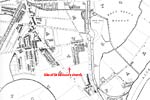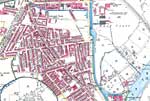For this church:    |
Nottingham St SaviourHistory
In 1862 the Rev Canon Brooks, vicar of St Mary’s Church in the centre of Nottingham, founded a small mission church in the most southern part of his parish. The town was spreading rapidly and the need for a more local presence in a previously semi-rural part of his extensive parish had been recognised. Only four years previously in 1858 there were only twenty inhabitants adjacent to the site. The building to be used was not purpose built, but rather a room over a shoe shop next to Mellor’s Factory on Arkwright Street. Plans for a more permanent and grander structure must have been developed also immediately, for a large site on the same street called Vicar’s Croft was purchased on 28 September. The following year a committee led by the Rev Canon Brooks placed advertisements in local newspapers inviting local architects to submit designs for two new churches in the parish: one to be built on Arkwright Street in The Meadows, the other to be built on St Anne’s Well Road. The committee selected local architect R. C. Sutton’s design for the proposed Arkwright Street church. On 28 September 1863 the foundation stone for the new church was laid by the Bishop of Lincoln. It was also announced that it was to serve a new district chapelry taken out of St Mary’s parish.
Although a large building, it was completed in less than a year, with the service of consecration being conducted on 26 September 1864; the Bishop of Lincoln preached the sermon and the Rev Canon Brooks was the officiating minister. The first service was held one month later on 28 October. The pace of the site development did not slow down and in 1865 the foundation stone for the church school was laid on part of the land to the south-east corner of the church. This building still exists but is no longer used as a school. In the church’s first year of ministry the records show that 112 communicants attended the Easter Day service, and in the same year, 41 females and 19 males were confirmed. Pew rents per seat were between 10s. and 16s., producing an income of £138 14s. from the 256 seats rented. The penultimate development on the site was the construction of a red brick vicarage on the south side of the church. The vicar applied for and received a loan of £600 from Queen Anne’s Bounty to fund his new home. This building is extant and used by the present incumbent.
Such was the population growth of the area, that in the next thirteen years three mission chapels were opened and serviced by the incumbents and curates of St Saviour’s. St Margaret’s Church, Crocus Street (1898), was, like its mother church, originally located above a shop, Dank’s the Ironmongers on London Road, midway between St Saviour’s and St Mary’s. This situation changed when Bishop Ridding of Southwell personally purchased a piece of land for a new church on Crocus Street. This was quickly followed by the erection in 1890 of St Gabriel's mission church, a ‘tin tabernacle’ in the south of the parish on the corner of Bathley Street and Lamcote Grove. This project was entirely funded by Mr. H. Abel Smith of Wilford. During this same period St. Augustine’s Mission was opened on Launder Road in the western part of the parish. This was a comparatively short-lived venture for in 1891 a new church of St. George was opened with its parish taken out of St. Saviour’s area. St Augustine’s Mission was incorporated within St. George’s. On the south wall of the chancel is a white marble tablet that records the repaving of the chancel in 1887: 
In 1892, despite the reduced area of the parish due to the opening of St. George’s, the ongoing activity at St. Saviour’s was substantial. The vicar needed to be supported by two curates to service his parish which numbered 16,000 residents in the 1891 census. In the 1890s further work was carried out at the church (including the building of a parish room adjacent to the vestry in 1893) as recorded on a brass plaque on the north wall of the chancel:
The Sunday School had 578 scholars with an average weekly attendance of 486. Fortunately, he had the services of 57 Sunday School teachers, and a team of 15 ladies for carrying out home visits. Other church activities included Bible class for men, Gleaners’ Union, Boys Brigade and Mothers’ Union. The Sunday School may have reduced slightly by 1897 as only 400 scholars attended the annual outing to Plumtree. In the same year the vicar expressed his concern regarding the high number of deaths in the parish due to cancer and tuberculosis. At the dawn of the twentieth century St. Saviour’s reported that the sale of the parish magazine had reached 2,000 copies a year. One hundred parishioners had attended the Annual Tea Party in the Parish Rooms, but the number of Sunday School teachers had reduced to 50. In 1911 the parish population was 13,583 and the number of Sunday School scholars had increased to 500. 132 Baptisms were performed and 39 confirmations took place. From 1900-19 few records appear to be available. The church has a large World War I war memorial on the north wall listing the names of the 223 parishioners who died. The only other record from that year was the announcement that pew rents were to be abolished. In 1940 falling attendances forced the decision to close St. Margaret’s Mission, which was subsequently requisitioned by the War Office as a storage facility for the duration of World War II. It was demolished in the 1950s. A similar fate followed for St. Gabriel’s Mission which closed in 1954, becoming a second-hand furniture warehouse prior to demolition in the 1970s. However St. Saviour’s continued to offer religious and social support for its parishioners. In 1964 the Sunday School had 245 scholars, with a total of 1,045 parishioners attending Sunday morning services and 630 attending evening services during the year. In 1988 the church activities are listed as a Friendship Club, Women’s Guild, Girl Guides and Brownies, Young Mums’ Group, Women’s Fellowship and Pathfinders’ club. By 1999 the regular congregation was reported as about 100.
In 2011-12 the church was reordered and in 2013 the Eden SoftPlay Centre was created in the nave. This involved the removal of the pews in the nave and aisles and the installation of large play equipment reaching up into the roof space. A catering facility with a kitchen and servery occupies part of the south aisle and seating fills the nave. Access to the chancel, which is said to be rarely used, is blocked by a removable barrier. Services are regularly held in the nave with the furniture being re-arranged to suit the needs of the congregation. The older St. Saviour’s Baptism and Marriages Registers are held at Nottinghamshire Archives. | ||||||||||||||||||||||||||||












